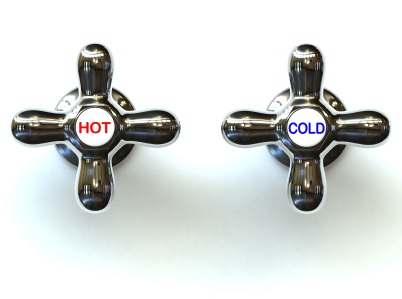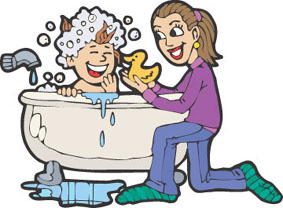Preventing Scalds and Burns in the Kitchen
- Teach children that hot things burn

- Place objects so they cannot be pulled down or knocked over
- Turn pot handles away from the stove's edge
- Keep appliance cords coiled and away from counter edges
- Keep hot food and liquids away from table and counter edges
- Use dry oven mitts or potholders. Hot cookware or tableware can heat moisture in a pot holder or hot pad, resulting in a scald burn
- If you have young children in the home, cook on the stove's back-burners
- When children are old enough, teach them to cook safely
Hot Tap Water and Scald Burns
Effective Sept. 1, 2004, all water heaters replaced or installed in Ontario are required to have an "anti-scald" device installed. A change was made to the

Ontario Building Code making anti-scald devices mandatory.
What is an Anti-scald device?
The water in your hot water tank needs to be maintained at 140ºF (60ºC) to prevent bacteria growth also known as Legionella bacteria. Legionella thrives in warm water environments, 49ºC (120ºF) or less, but is killed at 60ºC (140ºF) or above. However, water at this temperature can scald within a few seconds.
Thermal master mixing valves, also known as anti-scald devices, blend hot and cold water to deliver water out of the tap at a temperature of 120ºF (49ºC). You may choose to have "full-strength" hot water piped directly to the dishwasher and other appliances.
If your hot water tank was installed prior to 2004 you will be required to have thermal mixing valves installed when your hot water tank is replaced. Consider installing "anti-scald" devices on tub faucets and shower heads to prevent scalds.
Regardless of whether your water heater uses electricity or gas, an anti-scaled device is now required before any water heater tank can be replaced or installed. The anti-scald device becomes a permanent addition to the plumbing system and is the responsibility of the property owner to ensure that the device is installed and maintained.
If you do not yet have "anti-scald"devices installed for your hot water system, consider adjusting the thermostat setting on your water heater to no higher than 120 degrees Fahrenheit (49 degrees Celsius). The lower temperature lowers the risk of scalds and burns, but it also increases the risk of Legionella bacteria leading to Legionnaire's disease.
If you lower the temperature setting on your water heater, you will need to test the temperature at the faucet. Allow water to run 3 to 5 minutes. Test the water with a thermometer (meat, candy, or cooking). If the water is hotter than 120 degrees Fahrenheit (49 degrees Celsius), adjust the temperature of the water heater and wait a full day to allow the temperature in the tank to adjust. Re-test and re-adjust as needed.
Quick Tips
- If children are in the home, don't leave the bathroom while the tub is filling.

- Before placing a child in the bath or getting into the tub yourself, test the water.
- Fill the tub or sink by running cool water first and then adding hot water. Turn the hot water off first. Mix the water thoroughly and check the temperature by moving your hand, wrist, and forearm through the water. The water should feel warm, not hot, to the touch.
- When bathing a young child, seat the child facing away from the faucets so the child cannot reach the faucet. Turn the faucet to the "COLD" position.